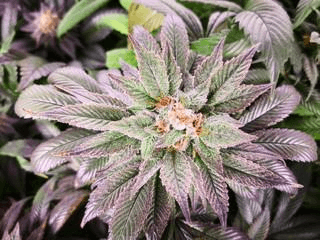Understanding the Causes of Bud Rot in Cannabis Plants

Cannabis is one of the most resilient herbs known to mankind. That explains why a plant once native to East and Central Asia now flourishes in virtually all climatic regions worldwide. In fact, marijuana’s “weed” moniker is a perfect connotation of the herb’s hardiness.
But despite its incredible resilience, cannabis isn’t entirely immune to pests and diseases. One common disease that plagues marijuana plants is known as bud rot.
What Is Cannabis Bud Rot?
One of the frequently asked questions among many cannabis growers is – what causes bud rot?
Now, bud rot may be a common cannabis problem. But as you shall find, the disease tends to be more prevalent during certain environmental conditions.
However, before we delve deeper into the possible causes of cannabis bud rot, we should perhaps begin by understanding this disease.
But rot, also known within the cannabis community as Botrytis or gray mold, is a fungal infection that affects marijuana flowers. Note that cannabis flowers are commonly referred to as buds. That explains why this disease is called “bud rot” and not “flower rot.”
As the name rightly suggests, bud rot causes cannabis buds to decay. Without timely interventions, the disease can quickly progress to other parts of the plant, resulting in massive economic losses.
It’s also important to note that bud rot isn’t only a cannabis problem. The disease affects nearly all plants that produce dense buds.

What Causes Bud Rot?
Bud rot is caused by the fungus Botrytis cinerea. The disease develops when this fungus infiltrates a plant’s buds and goes unnoticed long enough.
The Botrytis cinerea fungus can develop inside a plant’s buds for weeks before displaying the first symptoms, which makes it notoriously difficult to contain.
Another factor that makes bud rot difficult to control is that the causative agent is omnipresent. The Botrytis cinerea fungus exists in the natural environment as mold spores. These pores can easily travel from one farm to another, infecting thousands of plants.
As with most fungi, Botrytis cinerea is mainly carried about by air. And contrary to belief perception, this isn’t an outdoor-only problem. The disease can infect indoor plants too. However, outdoor plants usually bear the brunt as farmers have less control of the environmental conditions known to aggravate botrytis.
Since Botrytis cinerea is ever-present in the natural environment, the focus then should be to understand the trigger and aggravating factors.
Now, bud rot is inherently a humidity problem. High humidity levels generally provide the perfect conditions for mold growth in plants. The mere fact that botrytis is a mold or fungus explains why the disease typically rears its ugly head during humid conditions.
The following are other common factors that may trigger bud rot in plants;
1. Increased Precipitation
Plants require adequate rainfall or watering to thrive. However, overexposure to water droplets from precipitation might cause moisture to get trapped inside the bud tissues, aiding botrytis.
2. Low Temperature
Low temperature, in and of itself, will not automatically trigger bud rot. But the condensation usually deposited on plant leaves when conditions plummet to sub-zero degrees may cause high moisture saturation in the buds. This might consequently create a breeding ground for bud rot.
3. Inadequate Airflow
Spacing plants too closely may inhibit airflow throughout the garden. This might also trigger or worsen bud rot. Inadequate airflow is especially a common problem in grow rooms with insufficient fans or HVAC systems.
4. Dense Plants
Plants that produce dense foliage will naturally retain more moisture in their buds than they lose, potentially resulting in botrytis. The same problem is evidenced in plants with dense buds.

What Does Bud Rot Look Like?
The botrytis fungus can take on several appearances depending on the disease’s progress. The following are some of the signs of bud rot in plants;
- Rotten, brown buds
- The darker or purple coloration of the buds and leaves
- The mushy grayish coloration of the buds or stems
- Yellow, burnt, or wilted leaves
- Abnormal or deformed leaf growth
- White fluffy fungus on the buds
- Grayish-brown calyces
- Brown, curled, or dry leaves
- Visible signs of mold
- Small black spots on the buds or leaves
The initial symptoms of botrytis typically appear on the stems. You’ll first notice the grayish coloration of the upper stems.
Note, however, that botrytis initially forms inside the buds before moving to other parts of the plant. The symptoms don’t immediately appear in the buds due to the buds’ shape and location on the uppermost parts of the plant. As the disease progresses, the leaves will turn yellow, burnt, or wilted.
Botrytis is a highly contagious disease. Without early detection and prevention, the fungus will quickly spread to other parts of the affected plant and even infect other plants on the farm. Given the right environmental conditions, bud rot will only take a few weeks to spread to a fairly expansive area.

Final Word
Bud rot is a deadly fungus that can quickly take a toll on your plants if it goes undetected long enough. The best way to contain the disease is to prevent it from occurring in the first place.
That includes maintaining the right humidity and temperature levels. Also, ensure your plants’ growing space receives adequate airflow by properly spacing and pruning regularly.
